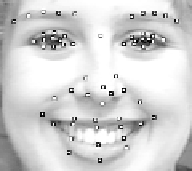Information Technology Reference
In-Depth Information
Fig. 1
Facial feature points
p
j
p
j
p
j
p
j
l
ij
y
ij
p
i
θ
p
i
p
k
ij
,
ik
p
k
l
ij
(a)
F
1
p
i
l
ik
p
i
(d)
F
4
,
F
5
(b)
F
2
(c)
F
3
p
j
p
j
p
j
l
ij
l
jk
i
θ
j
θ
k
A
ijk
A
ijk
p
i
p
i
p
i
θ
p
k
p
k
p
k
l
ik
(e)
F
6
(f)
F
7
(g)
F
8
Fig. 2
Facial features
3.2
Facial Feature Values
Some kind of facial features such as the ones defined in the Facial Action Coding
System [21] are considered to be useful for the recognition of facial expressions.
However, there is the personal differences in regard to the appearance and intensity
of facial expressions. Hence, it will be effective to personalize the facial feature
values used to recognize facial expressions.
We thus define eight types of facial features by combining two or three facial
feature points taking the computational efficiency into account. There are a large
number of possible combinations (i.e., possible feature values) on the basis of this
definition. Several useful facial feature values can be selected for each person to
recognize his/her facial expression accurately.
•
Length of a line segment (
F
1
)
This facial feature value is the normalized length of the line segment
l
ij
formed by
connecting two facial feature points
p
i
and
p
j
asshowninFig.2(a).Thelengthis
normalized by dividing it by the Euclidean distance
d
between the center points of
the left and right eyes in order to make the feature value independent of the scale of
the facial image. This facial feature can represent the relative positional relationship
between two facial components (e.g., an eyebrow and an eye).







































Search WWH ::

Custom Search